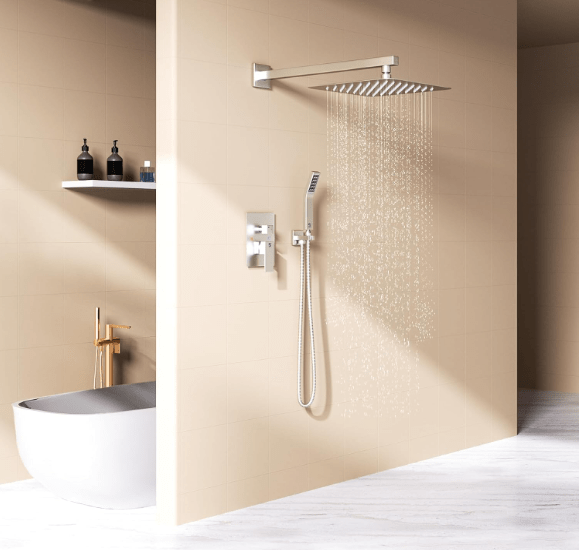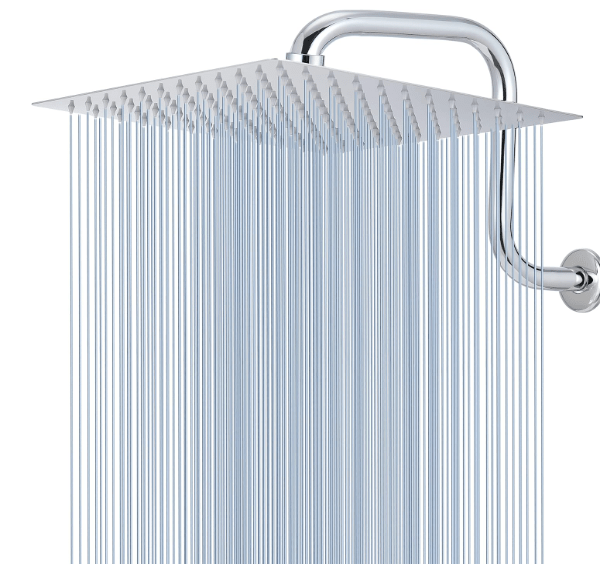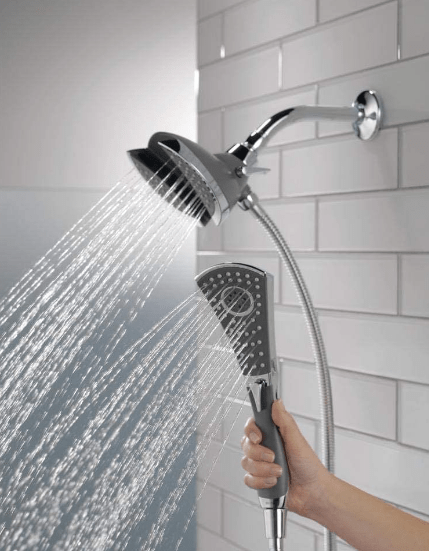Choosing the right comfortable height for your shower head is crucial.
Traditionally, a shower head should be placed somewhere around 80 inches from the floor. This is a universal standard positioning that will work for any average individual. It also holds true for different shower head types.
Standard Shower Head Height
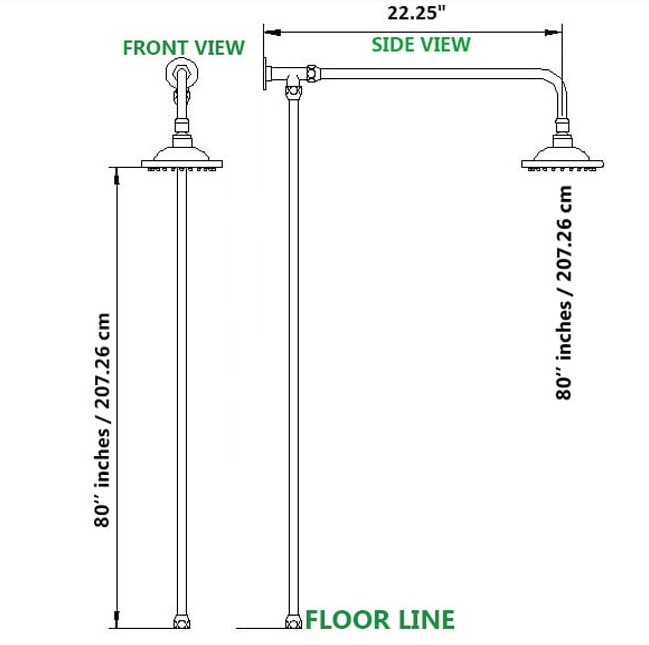
Industry shower head height is a standard and comes with a fixed shower head height from the floor. It is basically eighty inches (80”) or six feet and eight inches(6′ 5”)/207.26 centimeters (cm).
This is an ideal shower head height for people who are average or tall in height.
If you were looking for shower height, then the above measurements are perfect especially if you want a standard normal shower head height.
However, for those considering a custom made shower head height, make sure you consult your plumber on the best way that can suit you or your family.
Height of Shower Head Controls
To ensure that you have comfortable access to your shower head whether standing outside or inside the shower spray, the controls should be easily reachable for everyone despite their height.
The ideal height for a shower head control should be ranging between 38 inches to 48 inches from the floor. This will also rely on personal preference and style.
Importantly, the controls should be easily accessible and placed in a strategic position and height.
Shower Head Height Regulations
There is no fixed height for shower head height. This is because we all have different preferences and designs for our house and bathrooms.
There are, however, plumbing guidelines given when you don’t know the measurements in designing the height of your shower head.
But it’s of an essence to use the standard height so that your bathroom is suitable for any family member. Despite this, if you want something unique, you can toggle the measurements to come up with something for you or your family.
With the above standard shower head height, sometimes it is recommended to choose the most appropriate for easy installation. A shower head might be correct, but improper installation may ruin everything.
You can consider the following shower heads since each is ideal for a perfect shower head height;
What Is The Perfect Shower Head Height And Head Clearance?
Before we dive into the details, it is important to understand a few basics related to shower heads. Over the years, shower heads have gone through significant changes. In addition to standard shower heads, there are options that provide mist, spray, and even panel operations.
Each of these distinct designs and experiences calls for an optimum setup. As a result, a standard one-size-for-all doesn’t work anymore. Now let’s have a look at different shower head types and their optimum height.
Standard Wall Mounted Shower Head Height
It is the most common shower head and ideal for you if you consider using the industry standard shower head height. It should be around 80 inches.
The Rain Shower Head
Rain shower heads are the quintessential luxury setup usually found in large and high-end bathrooms. Due to its unique setup requirements, it is often considered a high investment choice for a bathroom.
A rain shower head is usually mounted in two ways – either on the wall or on the ceiling. There are distinct height requirements for each setup. For example, if you are opting for a wall mount, the ideal height of the shower head should range between 85 to 90 inches.
And if you are opting for a ceiling mount, the shower head should be positioned 5 to 6 inches below the ceiling bed.
Handheld Shower Head
Handheld shower head incorporated with 36” to 72” long hose pipe giving you the control, it also comes with a mount, hence very suitable for wall mounting.
Shower Head Height Codes
There might not be any regulation when deciding which shower head height to use. However, if you are looking for the appropriate shower head height, many sellers will provide you with the shower head height codes.
If you are considering using a standard wall mounted shower head, use a shower head height with measurements ranging from 80” off the floor or 6 to 8”.
For those using rain shower head, it will require you a 4-5 or 8” height while handheld shower head is best if fitted with 36 to 72” hose pipe that can also be mounted.
Shower Head heights can also be adjusted, but consult your plumber on how you can adjust it. Most of the modern designs are easy-to-adjust to improve and make the experience worthwhile.
Shower head control standard measurements are 38” to 48” above the ground. Installation and mounting should be at a position that can be easily seen and accessed whether in or out of the shower.
Shower Head Height For Tall People
The ideal height of the rain shower head should be enough for tall people. An 85 to 90 inch setup will clear people over 6 feet easily. However, the best approach, in this case, would be to go for a ceiling mount.
Go for the adjustable one as they are versatile.
Shower Head Height For Medium Height People
Medium height people can opt for an 80 to 85 inch rain shower head. This will keep the stream and the radius steady. However, the height doesn’t really matter with rain shower heads as it mimics the rain.
Shower Head Height For a Short People
The ideal setup for short people should be 78 inches. It’s still on the upper spectrum but that is to facilitate the radius and rough-in space. Anything shorter than this will ultimately ruin the shower experience.
With a rain shower head, greater height makes for an enjoyable experience as it simulates the rain. It’s also preferable that you use the ceiling mount option only if you have high bathroom ceilings.
Height Comparison Table
User Height | Shower Head Height | Valve Height |
Tall | 80 inches | 48 inches |
Medium | 76 inches | 48 inches |
Short | 72 inches | 48 inches |
Basic Principle of Determining Shower Head Height
By now it is clear that every bathroom has its own characteristics. Some are large, some are small. Others have a standard ceiling or a false one depending on the storage unit above. All of these greatly impact the shower head choice.
Before we look at the individual principles for different shower heads, there are a few key concepts that you need to get familiarized with.
The height of the shower head will partially determine the radius and water flow speed from the shower head. If you position it at a higher elevation, you will gain more water radius. But if you lower the shower head, you will get more pressure but then the radius gets reduced.
How To Determine Regular Shower Head Height
The basic principle mentioned above directly applies to regular shower heads. The determination of the shower head height should be based on the preference of either radius or water flow pressure.
But then again, there’s hardly a single member in a family. Each might have their own preferences which makes it a bit difficult to stick to preference.
In that case, we suggest using the average height formula. Find out the average height of the adult members of the family and set the shower head 5 to 6 inches above that.
This way it will ensure an effective showering experience.
How To Determine Handheld Shower Head Height?
Handheld shower heads are a bit trickier to deal with. But it also offers a more flexible height choice compared to regular shower heads.
The traditional 72 to 78 inches rule has been devised keeping the accessibility factor of the shower head in mind. That makes it near a tad above 6.2 feet in height.
But what if the user is above 6.2 feet in height? In that case, it is better to fix the upper position in line with the tallest member of the family and the lower position at a standard 40-inch height.
How To Determine Shower Head Control Valve Height?
The valve height isn’t really determinable by the user. Most of the shower head fixtures come with a standard height for the control valve.
For personal and customized use, the shower head control valve height can be determined by comparing the user’s height. Ideally, the shower control valve should align with the elbow joint.
This is just a general presumption to make the control valve more accessible.
The industry standards for shower head control valves are two – one for bathtub shower heads and the other for shower stalls. For bathtub shower heads, the control valve should not be anywhere above 28 inches. And for the shower stalls, the maximum height should be 48 inches.
Is There Any Adjustable Shower Arm Option Available?
Yes, there are several adjustable shower arm options. Shower arms are basically pipe extensions between the wall and the shower head itself.
What it essentially does is, increases the height clearance and rough-in space of the shower. Typically, shower arms ensure that the shower head covers a larger floor area by maximizing the rough-in radius. It’s also generally found to be more common in large bathrooms.
What Is the Perfect Shower Valve Height?
Shower valves are basically the control panel for shower heads. As a result, most ideal shower valves are designed with ease of access in mind. Ideally, a shower head set in the bathtub will have a 28-inch valve whereas a shower stall will have a 48-inch valve as mentioned earlier.
How Much Height Should Shower Ceiling Be?
The standard plumbing guide to showers states that there should be at least three to six inches of ceiling space above the shower head. That means an additional 6 inches should be counted for the ceiling keeping the shower head height in mind.
Typically, if a shower head height is 80 inches, then the shower ceiling should be at least 86 inches. On the higher spectrum, the height can be as high as 100 inches.
What Is the Best Height for A Shower Door and Enclosure?
The standard height of the shower door should be at least 72 inches. This is to facilitate people of varying heights easily into the bathroom. On the higher end, the shower door can be as tall as 96 inches.
The shower enclosure or the shower stall should be at least 36 by 36 inches wide. This allows for the perfect rough-in with all the standard heights mentioned above. Another standard choice is 36 by 48 inches which are typically seen in large bathrooms.
But the bare minimum in this regard should be 32 by 32 inches, or else you might end up bumping your head with the enclosing glass.
Conclusion
Beyond every standard procedure, the choice ultimately comes down to the users. If the users are larger or smaller than the normative choice, it will still work fine regardless. But the standard regulations provide for an optimum shower experience that will suit the need best without creating any issues.
If you’re planning on renovating your shower or building a new one altogether, keep the height guide in mind as it will surely aid in a smooth and effective experience.

Shower Head Placement Ideas
If considering building or remodeling your bathroom, you will always be compelled to install the best and standard-sized shower head. New and astounding showers are
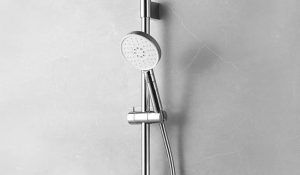
17 Best Handheld Shower Heads of 2023 Reviews
Let’s face it! If you are looking for a more efficient option than a fixed shower head, consider getting a handheld one. You can directly

How To Fix A Leaking Shower Head | Simple Guide With Steps
Standing under the shower with a shower head that gives out water at a wonderful water pressure, after a long day at work is blissful.
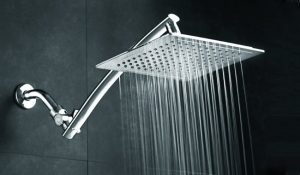
Does the Size of Shower Head Affect Pressure?
Buy a smaller shower head, and you get a higher water pressure. It is that simple, right? No, you’re wrong. If you buy a shower

HO2ME High Pressure Handheld Shower Head Review
The HO2ME shower head is a product of the G-Promise brand. This shower head has a beautiful design that catches the eye of any potential
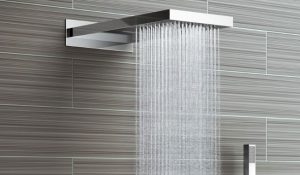
13 Best Luxury Shower Heads of 2023
The bathroom is the only place we want to keep it attractive and full of luxury items. For making your shower convenient full you will

